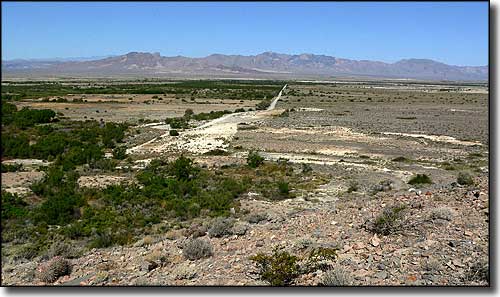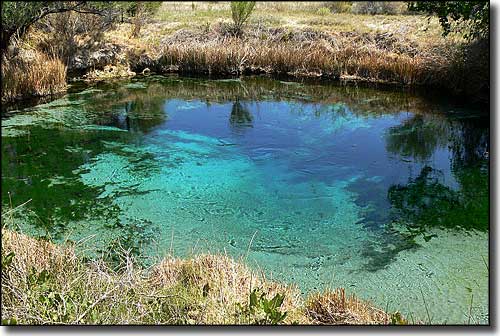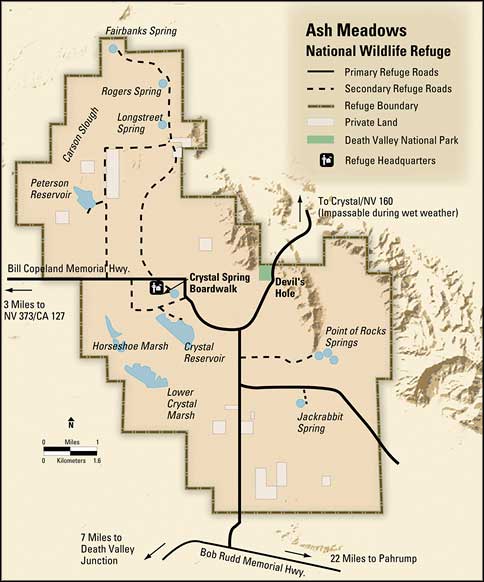 |
Ash Meadows National Wildlife Refuge |
|
|
 The view across Ash Meadows NWR |

Ash Meadows is a 23,000-acre refuge established to preserve and protect valuable and extemely rare desert oases in the Amargosa Valley near Death Valley in Nye County, Nevada. There are more than 30 seeps and springs that come to the surface of the desert floor here, making for a widely varied complex of habitats. There are at least 24 species of indigenous plants and animals found here that are found nowhere else on Earth. Currently on the endangered species' list are 4 local fish and 1 local plant. The endangered species of fish are the Ash Meadows Amargosa pupfish, Devils Hole pupfish, Warm Springs pupfish and the Ash Meadows speckled dace. There are also three other species of fish in the waters at Ash Meadows but they are all exotic introduced species and Fish & Wildlife is removing them from the ecological chain. The one endangered plant species is the Amargosa niterwort but six other species of plants are listed as threatened. Also listed as threatened is the Ash Meadows naucorid, an aquatic beetle. More than 27 species of mammals have been seen at Ash Meadows NWR, and 5 species of amphibians and 20 species of reptiles. Birds, though, that's a different story. Spring migration is usually during April and May, fall migration from mid-August through September. There are some species that live here all year round but all in all, more than 239 species of birds have been documented on the refuge. Picnicking, hunting (in season), birdwatching and wildlife observation are available activities at Ash Meadows. Swimming is allowed in Crystal Reservoir but you will be exposed to swimmer's itch (a skin infestation of certain flatworms that is very uncomfortable but is neither dangerous nor contagious - the larval stage of the flatworms penetrate the skin and cause a reaction that can persist for up to a week or more). Visitor facilities are still mostly in the planning stages so bring lots of your own water, some excellent sunscreen and a good hat. You don't want to be here (especially on these roads) when it's wet. For visitors, the first stop should be at the refuge office where you'll find brochures, an interpretive kiosk and the Crystal Springs Interpretive Boardwalk Trail. The office itself is usually open from 8 am to 4 pm, Mondays through Fridays (except Federal holidays) but with the staffing cutbacks in place these days, there isn't always anyone there. Ash Meadows National Wildlife Refuge was first established on June 18, 1984 but that doesn't mean all the planned amenities are in place yet: the refuge is still in its developmental childhood. So there isn't much for restrooms or drinking water. Picnic tables are rare and camping is just not available. To this point, refuge staff have been mainly occupied with habitat restoration, and have done so well that the Ash Meadows (Amargosa) pupfish has been proposed for removal from the endangered species list. On the other hand, Devil's Hole pupfish occur naturally in only one spot: Devil's Hole. Devil's Hole itself is a disjunct parcel of Death Valley National Park, and the spring is protected by chain link fence. Two other populations of Devil's Hole pupfish are maintained in other springs at Ash Meadows just in case some disaster hits Devil's Hole. You can see Ash Meadows pupfish in all the various springs but your best chance of seeing one is at Point of Rocks. Walking the Crystal Springs Boardwalk will allow you to get a good view of threatened plant species like the Ash Meadows gumplant, Ash Meadows ivesia and the spring-loving centaury plant. The Ash Meadows oasis is in this location because of a geologic fault that allows the discharge of water from an aquifer that stretches off one hundred miles to the northeast. More than 30 seeps and springs come to the surface here, with more than 10,000 gallons of water flowing every minute. With this amount of water being forced to the surface, wetlands and springbrook channels are all over the place. In the central part of the refuge are sand dunes, some of them rising as much as 50 feet above the surrounding areas. Along the streambeds and around the spring-fed pools, mesquite and ash groves flourish. The drier areas are dominated by saltbush, the elevated dry areas by creosote bush. And yes, this being an oasis in the desert there is cactus spread through the whole area. Ash Meadows is part of the larger Desert National Wildlife Refuge Complex, a grouping of sites that includes the Amargosa Pupfish Station and the Pahranagat, Moapa Valley and Desert National Wildlife Refuges. |
 Crystal Spring, one of many springs at Ash Meadows NWR  Ash Meadows National Wildlife Refuge area map |
|
|

|
| Index - Arizona - Colorado - Idaho - Montana - Nevada - New Mexico - Utah - Wyoming National Forests - National Parks - Scenic Byways - Ski & Snowboard Areas - BLM Sites Wilderness Areas - National Wildlife Refuges - National Trails - Rural Life Advertise With Us - About This Site - Privacy Policy |
| Photos of Ash Meadows National Wildlife Refuge courtesy of Stan Shebs, CCA ShareAlike 3.0 License. Map courtesy of the US Fish & Wildlife Service Text Copyright © by Sangres.com. All rights reserved. |